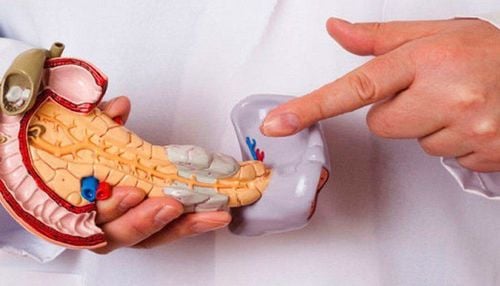This is an automatically translated article.
Fallopian tube cancer is one of the rare gynecological cancers. Older postmenopausal women are the group most commonly affected. There is increasing evidence that ovarian cancer begins in the fallopian tubes, so the risk factors for fallopian tube cancer are similar to those for ovarian cancer, including genetic risk. and did not give birth.
1. What is the stage of the cancer?
Cancer stage represents the location of the tumor and how advanced the cancer is in the body. To determine the stage of cancer, the doctor may order imaging tests such as ultrasound, CT, MRI; blood test for CA-125 tumor marker and biopsy procedure. Tumor staging is based on tumor size, location, and extent of metastasis. The FIGO system of the International Federation of Obstetricians and Gynecologists and the American Committee on Cancer (AJCC) TNM system can be used to stage fallopian tube cancer. The specific TNM system is as follows:
T: describes the size, location, and extent of the primary tumor N: indicates whether cancer has spread to the lymph nodes M: indicates the extent of metastasis of the mass u The doctor will use the test results to determine the tumor stage according to FIGO or TNM and combine these results to diagnose cancer stage 0 to IV.
2. What are the stages of fallopian tube cancer?
Fallopian tube cancer divides into stages similar to ovarian cancer. Both the FIGO and TNM systems are used for staging in fallopian tube cancer, specifically as follows:
2.1. AJCC and FIGO stage I Cancer is in the fallopian tubes, has not spread to nearby lymph nodes or to distant sites.
AJCC and FIGO stage IA: The tumor is in one fallopian tube and only inside the tube. It is not on the outside of the tube or in any fluid or wash from the abdomen and pelvis. Cancer has not spread to nearby lymph nodes or to distant sites. AJCC and FIGO stage IB: Tumor in both fallopian tubes but not outside the tube or in any fluid or wash from the abdomen or pelvis. Cancer has not spread to nearby lymph nodes or to distant sites. AJCC and FIGO stage IC: The tumor has not spread to nearby lymph nodes or to distant sites. Cancer in one or both fallopian tubes and any of the following: IC1: Tissue around the tumor that breaks down during surgery can lead to cell leakage into the abdomen and pelvis. IC2: Cancer on the outer surface of one or both fallopian tubes or rupture of a cyst before surgery. IC3: Cancer cells are found in fluid or washings from the abdomen and pelvis. 2.2. AJCC and FIGO stage II Cancer is in one or both fallopian tubes and has spread to other organs in the pelvis or has primary peritoneal cancer. The tumor has not spread to nearby lymph nodes or to distant sites.
AJCC and FIGO stage IIA: Cancer has spread or invaded the uterus or ovaries, has not spread to nearby lymph nodes or to distant sites. AJCC and FIGO stage IIB: Cancer is on the outer surface of or has grown into other nearby pelvic organs such as the bladder, sigmoid colon, or rectum. The tumor has not spread to nearby lymph nodes or to distant sites. 2.3. AJCC and FIGO stage III AJCC and FIGO stage IIIA1: Cancer in one or both fallopian tubes or primary peritoneal cancer and it may have spread to nearby pelvic organs. It has spread to retroperitoneal lymph nodes but not to distant sites. AJCC and FIGO stage IIIA2: Cancer in one or both fallopian tubes or primary peritoneal cancer. The tumor has spread or grown to other organs outside the pelvis. Cancer may or may not have spread to retroperitoneal lymph nodes, but not to distant sites. AJCC and FIGO stage IIIB: There is tumor in one or both fallopian tubes or primary peritoneal cancer and it has spread to organs outside the pelvis. The surgeon can see the tumor but it is no larger than 2cm. Cancer may or may not have spread to the retroperitoneal lymph nodes. The tumor has not spread to the inside of the liver, spleen, or distant sites. AJCC and FIGO stage IIIC: Cancer in one or both fallopian tubes and primary peritoneal cancer that has spread to organs outside the pelvis. The tumor is larger than 2 cm across and may be outside the liver or spleen. Cancer may or may not have spread to retroperitoneal lymph nodes but has not spread to the interior of the liver, spleen, or distant sites. 2.4. AJCC and FIGO stage IV AJCC and FIGO stage IVA: Cancer is found in the fluid around the lung and there is no other spread of the tumor. AJCC and FIGO stage IVB: Cancer has spread inside the spleen or liver, lymph nodes not in the retroperitoneal area, and/or to organs or tissues outside the peritoneal cavity.
3. Fallopian tube cancer treatment
Treatment for fallopian tube cancer depends on many factors such as the stage of the disease, medical history, current health and also the goal of treatment of the patient. The overall goal in fallopian tube cancer is to get rid of the cancer cells with as few side effects as possible. Treatments used may include:
Surgery: The type of surgery depends on the stage of the cancer. Tubal ablation is used to treat early-stage fallopian tube cancer. It is a procedure that removes one or both fallopian tubes and one or both ovaries. In more advanced stages of cancer, patients may need a total intra-abdominal hysterectomy (hysterectomy), bilateral tubal hysterectomy, appendectomy, peritoneal lavage, and peritoneal biopsy. desert. In patients with very severe disease such as end-stage fallopian tube cancer, the goal is to remove as many cancer cells as possible. Surgery may be used along with radiation or chemotherapy, also known as adjuvant therapy. Radiation therapy: Radiation therapy is the use of high-energy X-rays to kill cancer cells. Radiation therapy is not the main treatment for fallopian tube cancer. Because it is not very effective and patients often have some side effects. Radiation therapy may be used before surgery to help shrink the tumor. Chemotherapy: Chemotherapy is the use of anti-cancer drugs to kill cancer cells. Chemotherapy may be given after surgery to kill any remaining cancer cells. Commonly used drugs are cisplatin, carboplatin, gemcitabine, docetaxel, liposomal doxorubicin, cyclophosphamide, and paclitaxel. In some cases, intraperitoneal chemotherapy will be used. This is a method of chemotherapy that injects drugs directly into the abdomen, where the drug will be absorbed by nearby tissues and organs to destroy cancer cells. Your doctor will decide on the best treatment depending on your cancer and your needs. Targeted therapy: This therapy may also be used to treat recurrent or advanced fallopian tube cancer. Bevacizumab, entrectinib, and larotrectinib are targeted therapies that can be used in the treatment of fallopian tube cancer. Neratinib, olaparib, and rucaparib are targeted therapies used in fallopian tube cancer with BRCA+ results. In general, your doctor will explain your condition and treatments so you can choose the most appropriate treatment. This is a personal decision, but friends and family can help you discuss the pros and cons of each method. If you have any questions or concerns about fallopian tube cancer, don't hesitate to contact your doctor for specific advice.
Please dial HOTLINE for more information or register for an appointment HERE. Download MyVinmec app to make appointments faster and to manage your bookings easily.
Reference source: oncolink.org












